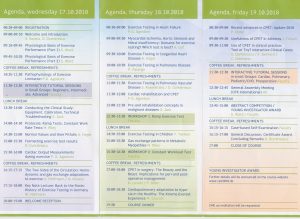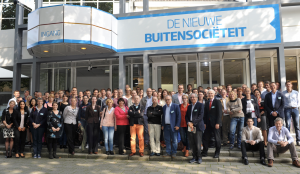Paolo Palange, Gabriele Valli, Paolo Onorati, Rosa Antonucci, Patrizia Paoletti, Alessia Rosato, Felice Manfredi, and Pietro Serra
J Appl Physiol 97: 1637–1642, 2004.
We tested the hypothesis that heliox breathing, by reducing lung dynamic hyperinflation (DH) and dyspnea (Dys) sensation, may significantly improve exercise endurance capacity in patients with chronic obstructive pulmonary disease [n = 12, forced expiratory volume in 1 s = 1.15 (SD 0.32) liters]. Each subject underwent two cycle ergometer high-intensity constant work rate exercises to exhaustion, one on room air and one on heliox (79% He-21% O2). Minute ventilation (VE), carbon dioxide output, heart rate, inspiratory capacity (IC), Dys, and arterial partial pressure of CO2 were measured. Exercise endurance time increased significantly with heliox [9.0 (SD 4.5) vs. 4.2 (SD 2.0) min; P < 0.001]. This was associated with a significant reduction in lung DH at isotime (Iso), as reflected by the increase in IC [1.97 (SD 0.40) vs. 1.77 (SD 0.41) liters; P < 0.001] and a decrease in Dys [6 (SD 1) vs. 8 (SD 1) score; P < 0.001]. Heliox induced a state of relative hyperventilation, as reflected by the increase in VE [38.3 (SD 7.7) vs. 35.5 (SD 8.8) l/min; P < 0.01] and VE/carbon dioxide output [36.3 (SD 6.0) vs. 33.9 (SD 5.6); P < 0.01] at peak exercise and by the reduction in arterial partial pressure of CO2 at Iso [44 (SD 6) vs. 48 (SD 6) Torr; P < 0.05] and at peak exercise [46 (SD 6) vs. 48 (SD 6) Torr; P < 0.05]. The reduction in Dys at Iso correlated significantly (R = -0.75; P < 0.01) with the increase in IC induced by heliox. The increment induced by heliox in exercise endurance time correlated significantly with resting increment in resting forced expiratory in 1 s (R = 0.88; P < 0.01), increase in IC at Iso (R = 0.70; P < 0.02), and reduction in Dys at Iso (R = -0.71; P < 0.01). In chronic obstructive pulmonary disease, heliox breathing improves high-intensity exercise endurance capacity by increasing maximal ventilatory capacity and by reducing lung DH and Dys.
Read entire article





